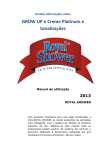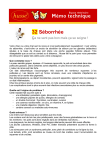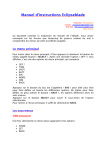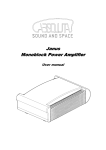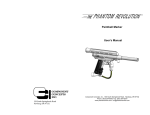Download ANS Gx3/Gx4 Manual
Transcript
GX-3 / GX-4 USER MANUAL CONTENTS: 4) GX-4 New Features • New Front-End Pneumatic Kit • New Adjustable Drop Forward Assembly • New Swing Trigger System • Packaged Barrel 2) Maintenance General Notes 3) Installation X-2 Inline Regulator 4) Adjustments • X2 Inline Regulator • Jack Hammer II Front Pneumatic Regulator • 3-Way Shaft • Sear Lug ©2003 ANS Xtreme Performance ANS Xtreme Performance 3885 Cochran Unit R Simi Valley, CA 93063 phone: (805) 527-5661 fax: (805) 527-2490 email: [email protected] www.ansxtreme.com www.ansusergroup.com ANS GX-3/GX-4 USER MANUAL GX-4 New Features The GX-4 marker comes with the same quality engineering and style that you’ve come to expect from ANS, plus a load of new features that improve performance, looks, and value. ANS GX-3/GX-4 USER MANUAL Maintenance INSTALLATION STEPS: GX-3 and GX-4 Maintenance Information 1. Identify the four ports on the inline regulator: GENERAL NOTES • IMPORTANT: If CO2 is used, it must be an Anti-siphon tank on both the GX-3 and GX-4 Cocker. • Always cock back the marker before installing a propellant tank. • GX Cockers are nitrogen-ready; Nitrogen is the recommended propellant. • The X-2 Inline Regulator needs to be installed on the new marker. (GX-3 only) GX-4 Marker New Front-End Pneumatic Kit Front-end pneumatics have been re-engineered for faster Rate of Fire (ROF). • The Jack Hammer has extra porting that improves gas recharge. • The 3-Way has additional exhaust porting for faster block return. GX-3 Marker New Adjustable Drop Forward Assembly The Adjustable Drop Forward with integrated ASA has: Installation • X-2 Inline Regulator Installation Quick disconnect on Drop Forward for easy disassembly 2 are labeled for input pressure. • 1 is labeled for output pressure. • 1 is the burst disc. 2. Installing the inline regulator into the marker body. Screw the regulator into the vertical ASA of the marker body until it stops. Do not torque. 3. Aligning the inline regulator. Unscrew the regulator until one of the pressure input ports faces the rear of the marker and the pressure output port is to one side of the marker. This will allow the micro gauge to be installed without interfering with the trigger guard. The exact position of the pressure output port can vary according to your preference, i.e. the gauge is facing the front and the line set up comes out the side. IMPORTANT: The regulator can be loosened almost 1-1/2 turns and still retain a perfect seal. It may move loosely and will appear to leak but as the system is pressurized the regulator will get ridged. In fact, 90% of the time most regulators are kept slightly loose or “backed off” to allow the input to be in the preferred spot. 4. Plugging the input pressure port. Two pressure input ports are provided so that the location of the gauge can be adjusted to your liking. One pressure input port will be connected to the propellant line and the other will be plugged. • Locate the 1/8" pipe plug and coat the threads lightly with red 262 Loctite. • Screw the pipe plug into ONE of the input pressure ports on the regulator. To maintain a good seal have the plug go flush with the regulator body. • Lightly coat the threads of the gauge with red 262 Loctite. • Install the micro-gauge into the Output Pressure orifice and tighten snug using a Crescent wrench. It is recommended that the micro-gauge be used, but it is not essential. If the microgauge is NOT installed, the pressure output port must be plugged as follows: • Locate a 1/8" pipe plug (supplied) and coat lightly with red 262 Loctite. • Screw the pipe plug into the output pressure port and tighten snug. 6. Installing the propellant feed line. • Whether you will be using a macro line fitting or nickel-plated connectors, the threads should be coated lightly with red 262 Loctite. • Screw the propellant feed line into the last available open input pressure orifice. X-2 Inline regulator installation is now complete. Proceed to the Adjustments section for calibration instructions. Adjustments X-2 Inline Regulator Adjustment On the GX-3, this part is not calibrated from the factory and requires adjustment when installed. Unlike conventional cockers that adjust velocity through the back of the marker, GX series markers require adjustments through the Quick Twist knob on the bottom of the regulator, NOT through the Internal Velocity Gauge (IVG). The IVG should not be adjusted on this marker. • Faster ROF and a new level of style On the GX-4, the X-2 Inline Regulator comes pre-installed and calibrated so that no adjustment is necessary. For all GX-3 markers, this section explains how to install the X-2 Inline Regulator. GX-3 users will then need to calibrate the part for normal use by following the instructions under the Adjustments section of this manual. The Inline Regulator installs vertically in front of the trigger guard and controls the velocity at which paintballs exit the marker. • Greater gas efficiency with improved N-2 Hammer Kit YOU’LL NEED: ADJUSTMENT STEPS: • Red 262 Loctite • 1/8" pipe plug (supplied in X-2 Rebuild Kit) 1. Locate the Quick Twist adjuster knob at the bottom of the inline regulator. • Micro pressure gauge (included) • Braided stainless steel propellant feed lines • Convenient on/off twist knob for easy gas tank activation New Swing Trigger System The improved action Double-Finger Swing Trigger Kit provides: Packaged Barrel The GX-4 comes complete with a new 14" 2-piece barrel: 2 • 5. Installing the micro pressure gauge. The micro-gauge indicates the pressure coming out of the regulator and is useful to determine optimal performance of the marker. • Ported and vented for improved performance • Large Crescent wrench • Matched to the marker for uniform style • 3/16 Allen wrench ANS Xtreme Performance: GX-3/GX-4 User Manual YOU’LL NEED: 3/16" Allen wrench and/or crescent wrench Inline Regulator 2. Loosen (counterclockwise) the 2 set screws (or the lock washer on newer models) on the bottom of the Quick Twist knob about 2 turns. ANS Xtreme Performance: GX-3/GX-4 User Manual 3 ANS GX-3/GX-4 USER MANUAL 3. Loosen (counterclockwise) the Quick Twist knob about 2 turns. 4. Open the gas valve to pressure up the marker. Nothing should happen because there is no tension on the Belleview washers inside the regulator. 5. Tighten (clockwise) the Quick Twist knob. This will compress the washers and allow pressure to flow into the marker. The microgauge will begin to register a pressure reading and the regulator will tighten against the body of the marker. Continue to tighten the Quick Twist knob as necessary to set the regulator to the recommended marker pressure. Most markers will achieve maximum performance between 225-275 PSI. 6. Fire the marker and recheck the pressure setting. 7. When the recommended operating pressure is set, tighten (clockwise) the 2 set screws (or the lock washer for newer models) on the bottom of the Quick Twist adjuster to lock it down. X-2 Inline Regulator adjustment is now complete. ANS GX-3/GX-4 USER MANUAL YOU’LL NEED: No tools ADJUSTMENT STEPS: 1. Set the marker in normal operational mode for firing. 2. Loosen (counterclockwise) the Jack Hammer knob, which is located to the front of the regulator. Shoot the marker to relieve the backpressure. You will notice that the back block will no longer move when the trigger is activated. 3. Push the back block forward towards the body. 4. Hold the trigger back and tighten (clockwise) the Jack Hammer knob slowly. As the pressure is increases and air cycles through the ram, the back block will start to move back. 5. When the stainless steel pump arm rod is fully extended or there is no longer any slack left on the back block, rotate (clockwise) the Jack Hammer knob another 1/4 turn and stop. 6. Release the trigger and shoot the marker. Jack Hammer II front pneumatic regulator adjustment is now complete. Timing Adjustments (GX-3 and GX-4) On a new marker, optimum timing is preset from the factory and should not be adjusted. Following extended marker usage, periodic timing adjustments should be made to assure continued optimum performance. Timing the GX-3 and GX-4 is a simple adjustment of two major components: Complete Pneumatic Kit • The 3-Way Shaft • The Sear Lug To achieve accurate timing results, adjust the 3-Way Shaft before attempting any adjustment to the Sear Lug. 3-Way Shaft Adjustment. Jack Hammer II Front Pneumatic Regulator Adjustment The Jack Hammer II regulator is located below the barrel to the front of the marker body. It regulates the pressure needed to operate the front pneumatics. NOTE: This part is preset from the factory and should not be adjusted on a new marker. Adjustment will be necessary only if the user has altered factory settings. 4 ANS Xtreme Performance: GX-3/GX-4 User Manual The 3-way is a small cylindrical piece, which sits at the front of the maker underneath the barrel. Extending from the top of the 3-Way are three barb fittings-two lead to the ram and one leads to the Jack Hammer. On all new markers, this part is preset from the factory and should not be adjusted at first. As the marker is used, it may be necessary to check over from time to time. The function of the 3-way is to allow regulated air to pass through to the front and rear barb of the ram. The 3-way plays a major roll in the proper function of the gun. YOU’LL NEED: 5/16" open end or needle nose pliers ADJUSTMENT STEPS: 1. Set the marker in normal operational mode for firing. 2. Hold the marker in your left hand and focus on the 3-way. Locate the brass shaft. It is located in the front of the 3-way and can be seen through the external vent port. On the backside of the 3-way you will find the actuator collar, it is hexagonal in shape and has two sets of holes tapped into the body. The set in the front is used to lock the 3-way shaft in with the collar (keep in mind only one set screw is used, the other port is left open.) The set in the rear houses the shaved nylon screws preventing the actuator rod from rotating out of adjustment. 3. Checking the shaft position. Still holding the marker in your left hand, place your thumb on the bend radius of the actuator rod (directly above the trigger) and push it forward. Note: On the GX-3 the trigger will be resting in a forward position when this step is in progress. However on the GX-4 the trigger will need to be depressed. This is due to the reverse characteristics of the swing frame. Look inside the front vent port of the 3-Way. Using your thumb, press the bent radius forward and notice the brass shaft move as pressure is applied. There is a slight gap between the trigger plate and the actuator rod. This is the gap we are eliminating by pushing the rod forward. Your goal is to have the brass shaft sit flush with the 3-Way body as the actuator rod is fully extended. Achieving this will give your marker its best performance. If the shaft does not sit in a proper position, it will either create a leak or slow down the action of the marker. 4. Adjusting the shaft position. Use a 5/16" open end or needle nose pliers to rotate the hex collar on the actuator rod so that the shaft tip and the 3-way body are on the same plane when the actuator rod is fully extended. Note: Turning the hex collar counterclockwise will lengthen the position of the shaft. Turning it clockwise will shorten it up. 3-Way Shaft adjustment is now complete. Sear Lug Timing Check The sear lug is the only internal component of the GX-3 or GX-4 that may require adjustment over a period of use. It is part of the hammer assembly and can be accessed through the timing hole located right behind the feed neck. The lugs position has a direct result on the firing sequence of the marker. Note: keep in mind that all the markers come timed and tuned to their optimum performance before they are shipped. Only after usage will you need to adjust the depth of the lug. Before any adjustments are made to the sear lug you will first need to perform a simple timing test. This will determine if the timing on your marker is delayed, advanced, or at optimum performance. Sear Lug Adjustment Hole (Timing) YOU’LL NEED: No tools CHECKING STEPS 1. Gas up the marker and fire it a few times. 2. Hold the marker in your right hand. 3. Pull back the trigger very slowly and pay attention to the release time of the lug of the sear plate. Marker timing is at OPTIMUM PERFORMANCE only if the full cycle of the trigger pull is broken down in this order: As you start pulling back on the trigger, you notice that the contact between the lug and the sear is positive. About half way into the pull, right before the 3-way actuates and forces the back block to move, the marker fires. After the marker has fired the back block needs to have full pressure going back. Note: keep in mind that the block needs to be resting against the body when the hammer strikes the valve pin. ANS Xtreme Performance: GX-3/GX-4 User Manual 5 ANS GX-3/GX-4 USER MANUAL Marker timing is ADVANCED if when the trigger is pulled slowly, the marker fires way before the back block starts to moves back. This indicates that there is too little contact between the lug and the sear creating a large gap in the firing sequence. Marker timing is DELAYED if when the trigger is pulled slowly, the back block moves back before the marker fires. This indicates that there is too much contact between the lug and the sear. Sear Lug timing check is now complete. 6. Check the adjustment. After each adjustment (turn on the Allen wrench), replace the bolt and fire the marker to check the adjustment made to the firing sequence. Remember to pull the trigger slowly when checking the timing on the marker. Sear Lug Adjustment 1. Ensure that the marker is de-cocked. Before any adjustments are made to the sear lug, you will first need to perform the 3-Way Shaft Adjustment and the Sear Lug Timing Check (see instructions above). If the timing check reveals that the marker is delayed or advanced, an adjustment will be necessary. If the firing sequence is at optimum performance, no adjustment is necessary. 2. Pull the Quick Pull bolt out of the back block. YOU’LL NEED: 1/8" Allen wrench (long) ADJUSTMENT STEPS FOR ADVANCING THE TIMING (MARKER TIMING IS DELAYED) 1. Ensure that the marker is de-cocked. 2. Pull the Quick Pull bolt out of the back block. 3. Locate the timing hole. The timing hole is located on top of the marker body right behind the feed neck. 4. Locate the sear lug Allen screw. Insert the Allen wrench into the timing hole to lock into the sear lug. Due to variations in spring tension or main spring set-ups the wrench may not fit immediately into the lug, but moving the cocking rod slightly back and forth will allow the Allen wrench to drop into the screw head. When the wrench is locked into place you will feel a noticeable resistance due to a nylon anti-vibration setscrew. 5. Raising the lug. Twist the Allen wrench counterclockwise 1/8 turn. This will decrease contact between the sear plate and the sear lug thus allowing the lug to slip off earlier. NOTE: Lug adjustment should be minimal and restricted to 1/8-turn intervals. 6 ANS GX-3/GX-4 USER MANUAL ANS Xtreme Performance: GX-3/GX-4 User Manual 7. Repeat the adjustment until timing is correct and the hammer releases at the right time. ADJUSTMENT STEPS FOR DELAYING THE TIMING (MARKER TIMING IS ADVANCED) 3. Locate the timing hole. The timing hole is located on top of the marker body right behind the feed neck. 4. Locate the sear lug Allen screw. Insert the Allen wrench into the timing hole to lock into the sear lug. Due to variations in spring tension or main spring set-ups the wrench may not fit immediately into the lug, but moving the cocking rod slightly back and forth will allow the Allen wrench to drop into the screw head. When the wrench is locked into place you will feel a noticeable resistance due to a nylon anti-vibration setscrew. 5. Lower the lug. Twist the Allen wrench clockwise 1/8 turn. Doing this will increase contact between the sear plate and the sear lug thus allowing the lug to be held a little longer. NOTE: Lug adjustment should be minimal and restricted to 1/8-turn intervals. 6. Check the adjustment. After each adjustment (turn on the Allen wrench), replace the bolt and fire the marker to check the adjustment made to the firing sequence. Remember to pull the trigger slowly when checking the timing on the marker. 7. Repeat as necessary. Repeat the adjustment until timing is correct and the hammer releases at the right time. Sear Lug adjustment is now complete. ANS Xtreme Performance: GX-3/GX-4 User Manual 7 ANS GX-3/GX-4 USER MANUAL ANS GX-3/GX-4 USER MANUAL BLOCK PLUG ON/OFF 8 ANS Xtreme Performance: GX-3/GX-4 User Manual ANS Xtreme Performance: GX-3/GX-4 User Manual 9 ANS GX-3/GX-4 USER MANUAL 10 ANS Xtreme Performance: GX-3/GX-4 User Manual






